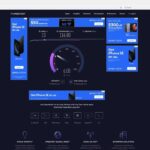In the relentless world of industrial automation, precision, durability, and efficiency are not just desirable—they are mandatory. At the heart of countless automated systems, from automotive assembly lines to advanced packaging machinery, lies a critical component: the linear actuator. Enter the Rosboxar 1000, a paradigm-shifting electromechanical actuator engineered to set new benchmarks in performance and reliability. This deep-dive article explores everything you need to know about the Rosboxar 1000, its specifications, applications, and how to calculate its key operational parameters for optimal integration into your systems.
What is the Rosboxar 1000?

The Rosboxar 1000 is a high-precision, heavy-duty ball screw actuator designed for industrial applications requiring exceptional linear motion control. It integrates a high-torque servo or stepper motor with an efficient ball screw mechanism, all housed within a rugged, hardened aluminum casing. This design provides superior thrust force, impressive positional accuracy, and remarkable longevity even in the most demanding environments. It is the go-to solution for engineers seeking to replace pneumatic systems with more controllable, cleaner, and quieter electric motion.
Key Features and Specifications
Understanding the Rosboxar 1000 means familiarizing yourself with its core technical lexicon. The following terms and specifications form the essential “keywords” that define its capabilities:
- Actuator Type: Electromechanical, Ball Screw, Linear Actuator, Motorized Actuator.
- Load Capacity: Dynamic Load, Static Load, Thrust Force, Force Rating, Load Rating (e.g., 5000 N dynamic, 10,000 N static).
- Stroke Length: Travel Length, Extension Length, customizable from 100mm to 1500mm.
- Speed: Linear Speed, Travel Speed, maximum of 300 mm/s.
- Precision: Positioning Accuracy, Repeatability, Backlash, often within ±0.01mm.
- Motor Compatibility: Servo Motor, Stepper Motor, NEMA 23, NEMA 34, Integrated Motor, Closed-Loop Control.
- Mechanical Components: Ball Screw, Lead Screw, Nut Assembly, Precision Ground Shafts, Linear Guides, Bearings.
- Durability: IP65 Rating, Dust Proof, Water Resistant, Corrosion-Resistant Housing, Hard Coated, Long Service Life.
- Control & Feedback: PLC Control, Modbus, CANopen, Ethernet/IP, Pulse & Direction, Limit Switches, Home Sensor, Encoder Feedback.
- Electrical Specifications: Input Voltage (24V DC, 48V DC, 110V AC, 230V AC), Current Draw, Power Consumption.
- Mounting & Integration: Compact Design, Flange Mount, Clevis Mount, Foot Mount, Easy Installation, Low Maintenance.
- Applications: Automation, Robotics, CNC Machinery, Material Handling, Packaging, Pressing, Lifting, Clamping, Positioning, Feeding, Assembly.
- Benefits: High Efficiency, Energy Saving, Quiet Operation, Clean Technology, High Stiffness, Smooth Motion, Programmable, Smart Control.
(FAQs)
Q1: Can the Rosboxar 1000 be used in dirty or wet environments?
A: Yes. The Rosboxar 1000 boasts an IP65 ingress protection rating. This means it is completely dust-tight and protected against low-pressure water jets from any direction, making it suitable for wash-down environments in food and pharmaceutical processing.
Q2: What is the difference between dynamic and static load capacity?
A: Dynamic Load is the maximum recommended force the actuator can apply while in motion. Static Load is the maximum force it can hold safely when stationary. Exceeding these ratings can lead to premature wear or catastrophic failure.
Q3: Is backlash a concern with the Rosboxar 1000?
A: The Rosboxar 1000 utilizes a pre-loaded ball nut design that minimizes backlash to negligible levels (typically < 0.01mm), ensuring highly precise and repeatable positioning crucial for applications like CNC machining or micro-dispensing.
Q4: How do I select the right motor for my Rosboxar 1000 actuator?
A: Motor selection depends on your application’s required speed, thrust force, and duty cycle. Our calculations below will help determine the necessary torque. Rosboxar provides compatibility charts matching their actuators with recommended servo and stepper motors based on these calculated values.
Q5: What maintenance does the Rosboxar 1000 require?
A: Maintenance is minimal. Primary tasks involve periodically checking for loose mounting bolts and re-lubricating the ball screw at intervals recommended in the manual (e.g., every 1,000 km of travel).
Practical Calculations for System Integration
Properly sizing and selecting an actuator is critical. Here are the key calculations for the Rosboxar 1000.
1. Calculating Required Thrust Force (F)
This is the most critical calculation. The force needed must overcome the process force and friction.F = F_process + F_friction
F_process: The force needed for the task (e.g., 2000 N to press a part).F_friction: The force to overcome friction in the system. For a load on a surface,F_friction = μ * m * gμ(mu) = coefficient of friction (e.g., 0.3 for steel on steel)m= mass of the load (kg)g= acceleration due to gravity (9.81 m/s²)
Example: You need to press with 2000 N and move a 100 kg sled (μ = 0.2).F_friction = 0.2 * 100 kg * 9.81 m/s² = 196.2 NTotal Thrust F = 2000 N + 196.2 N = 2196.2 N
You would select a Rosboxar 1000 model with a dynamic load rating greater than 2196.2 N.
2. Calculating Linear Speed (V)
The actuator’s speed is determined by the motor’s RPM and the ball screw’s lead.V (mm/s) = [RPM * Lead (mm/rev)] / 60
Lead: The linear travel distance per one revolution of the screw.
Example: Your motor runs at 1200 RPM, and the ball screw has a lead of 10 mm.V = (1200 RPM * 10 mm/rev) / 60 = 200 mm/s
This is within the Rosboxar 1000’s maximum speed specification.
3. Estimating Motor Torque (T)
This torque calculation ensures your motor can provide the necessary force.T (N.m) = [F * Lead] / (2 * π * η)
F= Required Thrust Force (N) from Calculation 1.Lead= Screw lead in meters (e.g., 0.01 m for a 10mm lead).π= Pi (~3.1416)η(eta) = Efficiency of the ball screw (typically ~0.9 for a ball screw).
Example: Using our previous force of 2196.2 N and a 10mm (0.01 m) lead screw.T = (2196.2 N * 0.01 m) / (2 * 3.1416 * 0.9)T = 21.962 / 5.6547 ≈ 3.88 N.m
You would need a motor capable of delivering at least 3.88 N.m of continuous torque.
4. Duty Cycle Check
A high duty cycle (频繁启停或连续运行) generates heat. Ensure the calculated torque and speed fall within the actuator’s continuous duty region on its performance graph to prevent overheating and ensure a long operational life.
Conclusion
The Rosboxar 1000 is more than just a component; it is a robust and intelligent solution for modern industrial automation challenges. Its blend of rugged construction, high precision, and ease of integration makes it an invaluable asset for optimizing production lines. By understanding its key features and applying the fundamental calculations for force, speed, and torque, engineers and system integrators can confidently deploy the Rosboxar 1000 to achieve new levels of efficiency, accuracy, and reliability in their applications.










